The HUB made a stopover in Moscow en route to the Routes CIS forum in Ekaterinburg to learn more about the development plans of the fast-expanding Transaero Airlines.
The aviation industry has witnessed considerable change over the past decade. The arrival of the low-fare business model across the globe has forced main established carriers to take a long look at their business models and in some cases re-invent themselves. Levels of service at many airlines across the world have certainly fallen, as management have attempted to reduce costs to compete with the growing low-fare sector. However, for one airline in particular a strong focus on training, innovation and customer service has been a key part of its development, and an area that the airline is continuing to invest heavily in.
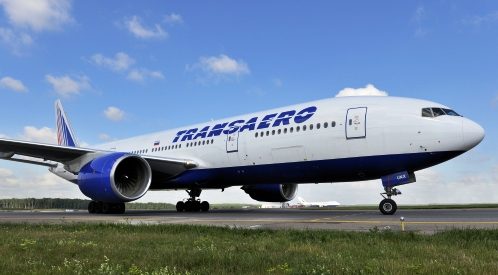
When Russian carrier Transaero was established in September 1990 the local industry was suffering some major cultural differences. National carrier Aeroflot and its various regional directorates, or ‘babyflots’ as they were affectionately called, had business models developed in Soviet era, when air travel was principally a domestic concern to support the inadequate surface transportation across the Soviet empire. The majority of flights were not run on a commercial basis but to provide a network of support around the Union in the event of a conflict with the West of China.
As a start-up Transaero was able to adopt a more commercial perspective of the industry, supporting the travel needs of the population but while generating a profit for investors. And this included the need to offer passengers a much higher quality service than the country’s operators had hitherto provided. This has subsequently resulted in the airline becoming the first Russian carrier to introduce Business Class on domestic routes; prohibit smoking on board; launch a frequent flyer programme, create a system of flexible and discount fares; open an automated check-in system; introduce electronic ticketing and facilitate on-line check in.
The airline celebrated its coming of age (21st birthday) last year by revealing significant growths in traffic and more importantly profits. In the 2011 calendar year the airline handled 1.78 million passengers on its domestic network and 6.67 million on its international flights, up 32.4 per cent and 25.9 per cent on the previous year, respectively. Revenues increased by 42 per cent on 2010 to RUB86.5 billion and the carrier recorded a net profit during 2011 of RUB1.83 billion, up a massive 215 per cent on the previous year.
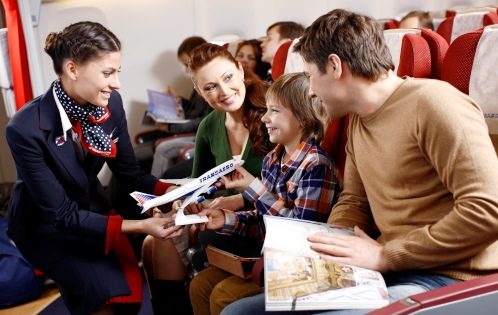
The airline’s General Director Olga Pleshakova has been one of the driving forces in the success and securing many of these Russian industry ‘firsts’. The wife of Alexander Pleshakov, the company’s Chairman of the Board, Mrs Pleshakova has worked at the airline since 1992 holding a variety of management roles in quality control and airline services. In 1999 she was appointed First Deputy General Director, before taking over as General Director in 2001, becoming the first female airline boss in the country.
Speaking to The HUB a couple of years ago, Mrs Pleshkova confirmed the importance of the airline providing a high level of service to its customers. “In such a competitive marketplace it is essential that you have a product that differentiates yourself from your rivals. Many airlines attract passengers on price alone, but this is not a sustainable solution. You must have a product that people enjoy and that makes them feel special and loved.
“It’s not a secret that Russians are kind, open and hospitable by nature. That’s why we always try to create the maximum possible comfort for our passengers during their whole trip - both in the air and on the ground. Our crews serve them with love, care and attention, and to my mind, this has played a major role in us increasing our passenger numbers year-on year for the past decade.”
|
TOP FIVE DOMESTIC RUSSIAN AIRLINES (non-stop departures; July 2012) |
|||||
|
Rank |
Airline |
Monthly Flights |
Monthly Seats |
% Total Domestic Capacity |
% Change (2011) |
|
1 |
Aeroflot Russian Airlines (SU) |
5,386 |
790,729 |
18.3 % |
17.7 % |
|
2 |
UTair (UT) |
7,045 |
761,202 |
17.6 % |
32.4 % |
|
3 |
S7 Airlines (S7) |
3,770 |
521,380 |
12.0 % |
7.0 % |
|
4 |
Transaero Airlines (UN) |
2,066 |
319,154 |
7.4 % |
37.9 % |
|
5 |
Rossiya Airlines (FV) |
2,701 |
283,322 |
6.5 % |
25.7 % |
Transaero was officially incorporated on September 30, 1990 becoming the first airline to be awarded an Air Operator’s Certificate (AOC) following the collapse of the Soviet Union. It launched passenger charter flights on November 5, 1991 between Moscow’s Sheremetyevo Airport and Tel Aviv, Israel using a Tupolev Tu-154, leased from Aeroflot. In March 1993 Transaero took delivery of its first Western aircraft, a former Luxair Boeing 737-200. The 737-200 was to be the first of a number of different western models to join the fleet during the 1990s – its first 757-200 arrived in April 1994, while two former American Airlines Douglas DC-10s were added in 1997 for transatlantic flights to Los Angeles although these were replaced by a single 767 before the end of the decade. The airline now has a mixed fleet of Classic and Next-Generation 737s, 767s and a mix of 747 and 777 variants, the latter being used on both domestic and long-haul international services.
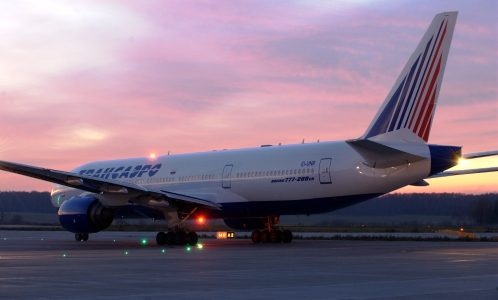
In the week preceding Routes CIS, Transaero went on its latest shopping trip, visiting the St Petersburg International Economic Forum in Russia’s second city and returning to the capital with a new order for the Sukhoi Superjet and formalising an earlier Memorandum of Understanding (MoU) with Airbus for the A380 together valued at almost $2.3 billion at list prices. These followed recent deals to acquire 320neos from Airbus and 747-8Is and 787 Dreamliners from Boeing. But, what are the airline’s plans for these new aircraft and what network opportunities will they create?
“We will use these new aircraft partly for fleet renewal but also to enhance our activities in some key existing markets and to take advantage of the better operating economics of the latest generation airliners to open new air links across Russia, the CIS and wider international markets,” explained Dmitry Stolyarov, Deputy Director General, Transaero Airlines in an exclusive interview with The HUB. “However, we will retain a number of our existing fleet as many Classic 737s and 767s are coming to the end of finance leases. As we will shortly own these outright they will become cheap for us to operate and we will retain then for this reason.”
The airline’s four A380s will be configured in a three-class interior seating around 700 passengers and have been ear-marked for use on the airline’s leisure routes serving markets like Egypt, Thailand, Turkey and the Caribbean. “At the moment the largest demand for this sized aircraft is mainly to leisure destinations,” said Stolyarov. “By the time we receive the first aircraft in 2015 we hope the business climate in Russia will have continued to grow, by which time we could consider flying them on business routes.”
These routes are candidates to be flown with the airline’s new 747-8Is. Transaero has four of the type on order and plans to configure them in a four-class arrangement seating around 460 passengers. “They will enable us to continue our development in the North American and Asian markets,” confirmed Stolyarov. “With a strong onboard product we will have a service that is competitive with others on these key business routes.”
|
TOP FIVE INTERNATIONAL RUSSIAN AIRLINES (non-stop departures; July 2012) |
|||||
|
Rank |
Airline |
Monthly Flights |
Monthly Seats |
% Total Int’l Capacity |
% Change (2011) |
|
1 |
Aeroflot Russian Airlines (SU) |
3,963 |
636,463 |
23.4 % |
17.6 % |
|
2 |
Transaero Airlines (UN) |
1,604 |
366,523 |
13.5 % |
37.7 % |
|
3 |
S7 Airlines (S7) |
1,010 |
162,720 |
6.0 % |
12.5 % |
|
4 |
Rossiya Airlines (FV) |
908 |
151,852 |
5.6 % |
48.0 % |
|
5 |
UTair (UT) |
508 |
81,274 |
3.0 % |
76.1 % |
The arrival of four 787 Dreamliners in 2014 will also open up new opportunities for Transaero. Configured in a three-class, 262-seat arrangement they will enable the carrier to operate routes that were previously not viable with larger equipment and could be used on direct routes from Russia to destinations in Brazil and Australia, for example. “This is the reason we selected the aircraft,” explained Stolyarov. “We can take advantage of the excellent operating economics and efficiency of the airliner to serve destinations that we previously could not reach directly.”
However, it is actually the arrival of up to 16 Sukhoi Superjet 100-95Bs that could mark the most notable short-term development for Transaero. The airline has placed a firm order for six of the aircraft and option for ten more for delivery between 2015 and 2017 and will configure them in a two-class arrangement seating 8 Business Class and 82 Economy passengers. According to Stolyarov, these aircraft will be used to open up new regional bases in Russia’s North West and Far East enhancing domestic connectivity in these regions. The initial base will be in St Petersburg, with the second (using the option aircraft) to be located at either Khabarovsk or Vladivostok. “These aircraft will take part in realization of a very ambitious challenge which faces Russian aviation – the development of affordable regional air transportation,” he added.
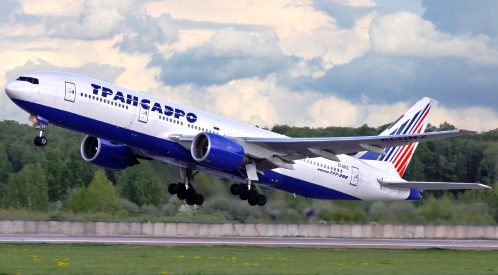
Transaero was initially established at Sheremetyevo Airport in the Russian capital but since 2001 Domodedovo has become its main home in the city. At this time, Domodedovo was one of the smaller facilities but a significant investment has seen it position itself as Moscow’s largest airport by passenger traffic. However, this growth has come at a slight cost for Transaero with limited capacity now available for its growing fleet of widebodied aircraft. As a result the airline is now operating a split airport model with flights from Sheremetyevo, Domodedovo and most recently the introduction of domestic and international services from Vnukovo.
According to Stolyarov, Sheremetyevo is mainly used as its leisure gateway with charter services to a number of international destinations. These are all flown using widebodied equipment, he said due to the runway and airspace limitations that restrict capacity. Domodedovo remains Transaero’s main Moscow gateway but it is now also developing its activities at Vnukovo having signed a long-term agreement with the airport operator to build its network from there.
“We are initially using Vnukovo to serve some of the destinations that we have multiple daily frequencies for example Tel Aviv and Kiev, splitting the schedule between Domodedovo and Vnukovo,” explained Stolyarov. “We are also aware that the more efficient transport links into downtown Moscow from Vnukovo would be popular with business passengers and we are ensuring we offer flight schedules that meet this demand. We have also switched our domestic flights to Khabarovsk and Petropavlovsk-Kamchatka to take advantage of the connection opportunities at Vnukovo.”
As has been the case with its 747 and 777 equipment, the airline’s new ultra-large aircraft could be used on some of its domestic sectors, which in some cases are the equivalent of a long-haul flight without crossing international borders. Transaero will likely be working with some airport operators to prepare for the arrival of the new models. “We have spent a lot of time working with airports to increase their ratings to handle our widebodied aircraft,” acknowledged Stolyarov. “There are probably 15 airports across the country that have increased their ratings due to Transaero initiatives and assistance.” In the meantime, Transaero continues to work with airport officials in Magadan, Novosibirsk, Ekaterinburg and Blagoveshchensk to prepare for the entry of its larger 747 and 777 equipment in these markets.

In the past few years the airline has strengthened its position in Russia’s regions and alongside its activities at Moscow and a long-term charter offering from St Petersburg, new direct international flights are now being offered from Ekaterinburg, Kazan, Khabarovsk, Krasnoyarsk, Novosibirsk, Samara and Ufa. “We see there is a lack of capacity in airspace and airports around Moscow,” noted Stolyarov. “This is why we have had to put a greater emphasis on our regional programme.”
Five years ago Transaero was solely a charter airline but now around 85 per cent of its flights are flown on a scheduled basis. This figure would be higher by one major barrier continues to restrict its growth… bilateral restrictions in Russia. “The fact is that the majority of the bilateral agreements were concluded in the times of the Soviet Union when there was only one carrier, Aeroflot. All agreements therefore limited the rights to just a single carrier from each side,” explained Stolyarov.
According to the Transaero executive there are currently still 71 international agreements in place that limit the operations from Russia to a single local carrier, but he acknowledged there has been a move to liberalising the market. “In most cases it is Transaero that has been the driving force of this liberalisation,” Stolyarov added. There are still a number of ‘closed’ markets that remain attractive to Transaero and it is currently working with the authorities to try and secure access. “Prague in the Czech Republic interests us, as does parts of Scandinavia, while CIS markets of Turkmenistan and Kyrgyzstan have a lot of potential,” said Stolyarov.
However, there have been successes in 2012. Alongside its new routes to Los Angeles and Yerevan, Transaero launched its first scheduled flights to Italy in June with links to Milan, Rome and Venice from Moscow and St Petersburg. Later this year the airline will inaugurate flights from Moscow Domodedovo and Vnukovo airports to Paris Orly, codesharing with Aigle Azur on the latter route. It is also set to inaugurate flights to Tokyo from both Moscow and St Petersburg and has already secure slots at Narita Airport for the services.
Looking ahead Transaero is studying the Indian sub-continent and hopes to introduce its first services before the end of this year with Stolyarov explaining that flights to Amritsar could commence in the “near future”. The airline also has fifth freedom rights to offer links from Moscow to Singapore via New Delhi and this is another growth option into this region.
Although Transaero has worked relatively closely with many of the Star Alliance membership and has been mooted as the ideal candidate to fill the big Russian void in the alliance’s network, Stolyarov said there are no immediate plans to join the grouping or one of its rivals. “We are open for discussions with any airline or alliance, together or separately,” he explained. “If Star Alliance is interested in securing us as a partner we are open to talks.” With no current ties, Transaero is free and single to enter partnership with who it pleases and Stolyarov believes at the immediate point in time this is the best course of action for the business.
One key partnership decision just around the corner is what will occur on the busy Moscow – London route. Transaero had co-operated with UK carrier bmi British Midland International between the two cities with each offering a double daily service. However, following bmi’s purchase earlier this year by International Consolidated Airline Holdings (IAG), the parent of British Airways (BA) and Iberia, its existing arrangement will cease to exist at the end of the Northern Summer schedules in late October.
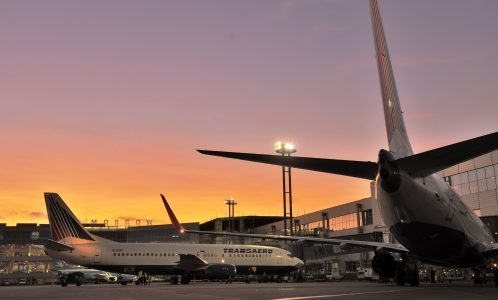
Under the terms of the bilateral agreement between Russia and the UK, the UK Civil Aviation Authority (CAA) is permitted to allocate a second UK carrier on the route and it is expected to make a decision within the coming weeks. Virgin Atlantic and easyJet are understood to be the likely candidates and Stolyarov confirms Transaero is “ready to co-operate” with whoever secures the rights. The Russian carrier is understood to have already held informal talks with Virgin Atlantic including discussions about potentially flying the route for the UK carrier as it currently does not have the aircraft capacity for the service. “Our experience shows that our partnership with bmi was a success for both parties. We wouldn’t actual rule out co-operating with BA either,” added Stolyarov.
Transaero certainly has ambitious plans to position itself as a principal operator in Russia’s domestic and international markets and its fleet expansion policy shows it has the financial muscle to support its growth aspirations. With major upgrades to its in-flight product also part of its short-term investment the young pioneer is looking forward to more Russian firsts as it continues its dramatic growth.





